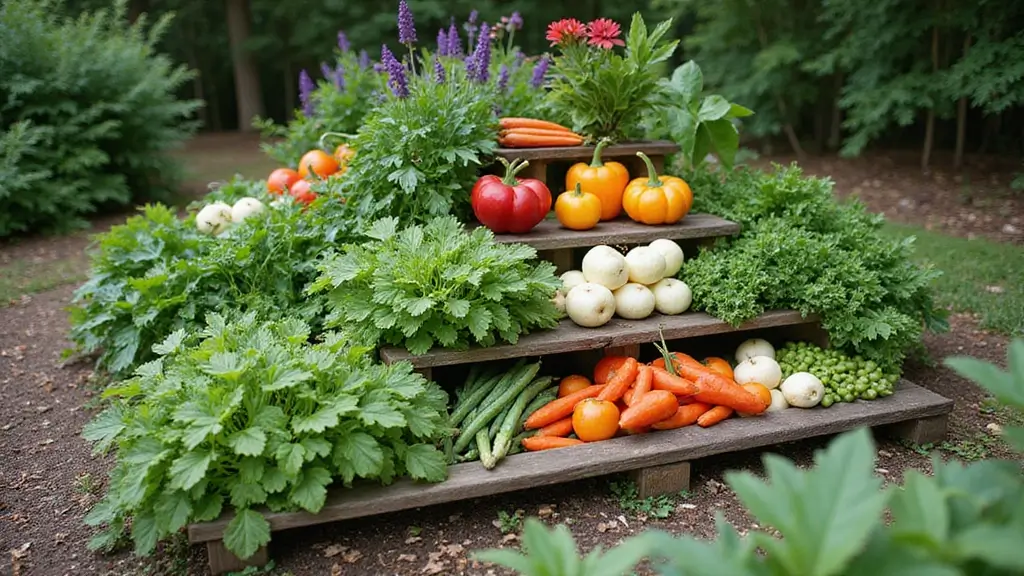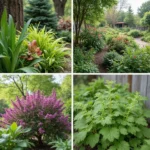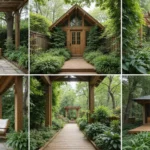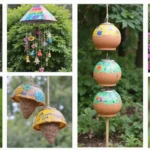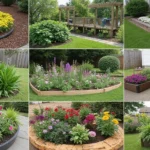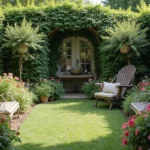Gardening enthusiasts are constantly on the lookout for fresh and creative ways to make their outdoor spaces bloom.
A tiered garden does just that! With its multi-level design, a tiered garden not only maximizes your growing area but also adds a stunning visual appeal to your yard.
From vibrant vegetable patches to elegantly arranged flower beds, these 30 tiered garden ideas will inspire you to create a gorgeous space that reflects your style and culinary ambitions. Get ready to transform your garden into a layered masterpiece that’s both beautiful and functional!
1. Classic Raised Tiered Bed
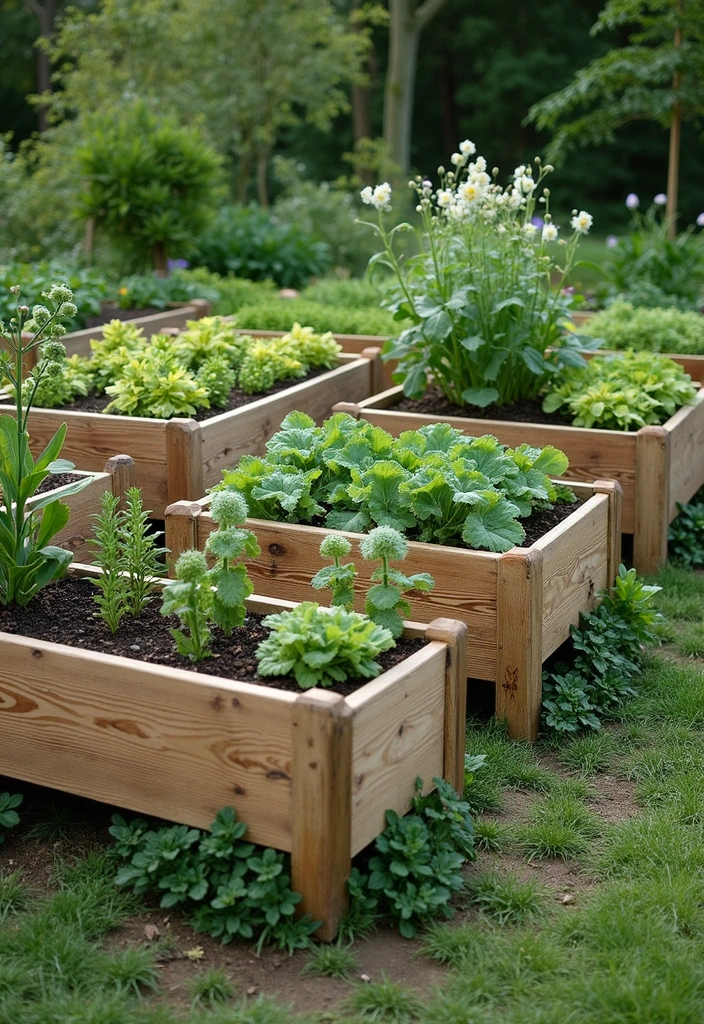
The classic raised tiered bed is the quintessential choice for homeowners who love both aesthetics and functionality in their gardens.
Constructed with wooden planks or bricks, this design elevates your plants to varying heights, making it easier to tend to them without excessive bending. You can create multiple tiers in a zigzag pattern or go for a more traditional step-like structure.
Benefits:
– Improves drainage and soil quality
– Reduces weed competition
– Adds a structured beauty to your yard
For a stunning look, consider filling each tier with different types of vegetables or herbs. Imagine having vibrant tomatoes cascading down one side while fragrant basil sits at eye level. Incorporating colorful flowers like marigolds into the mix can also help deter pests naturally.
Regularly check for moisture levels as elevated beds can dry out faster than traditional gardens. Mulching is your best friend here, keeping moisture in while adding a pop of decor.
Consider accessibility; a well-designed raised bed should allow easy access to all sides for planting and harvesting.
Elevate your gardening game! A classic raised tiered bed not only makes tending to your plants easier but also boosts drainage and reduces weeds. It’s beauty and functionality in perfect harmony!
2. Vertical Herb Tower
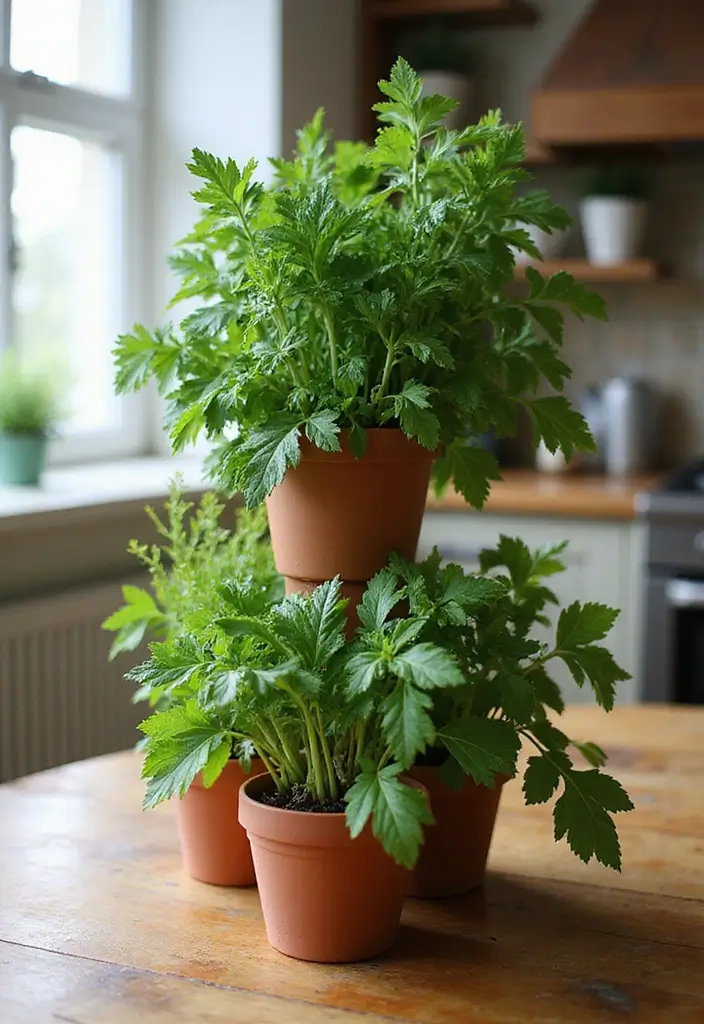
Turn your love for cooking into a fresh garden venture with a vertical herb tower!
These innovative structures can fit snugly in small spaces yet yield a variety of herbs all at once. You can use stacked pots, repurposed pallets, or even a purpose-built vertical planter. Herbs like basil, parsley, and mint thrive in such setups, and you can harvest them for your favorite dishes all summer long.
Why you need one:
– Space-efficient
– Easy to maintain
– Allows for easy harvesting
Position it near your kitchen or dining area for maximum convenience, and don’t forget to add some decorative elements like fairy lights to make it an evening spectacle. Keep a close eye on the watering needs; vertical gardens can dry out quicker, so consider drip irrigation for a steady supply of moisture.
3. Stone Tiered Wall Garden

Creating a stone tiered wall garden combines the rustic appeal of stonework with your gardening passion.
Using natural stone or boulders, build a wall that slopes downward, creating multiple planting levels. This approach is particularly popular for sloped yards and can dramatically enhance the landscape’s overall ambiance.
What makes it appealing:
– Provides excellent drainage
– Natural aesthetic that blends well with the environment
– Can be built to any desired height
Plant drought-resistant species like succulents and perennials that will thrive in this setup. Adding flowers that cascade over the edges brings an artistic flair. Incorporate ground cover plants to fill gaps and reduce erosion. Make sure to provide ample soil depth to ensure your plants can establish themselves well.
4. Pallet Planter Garden
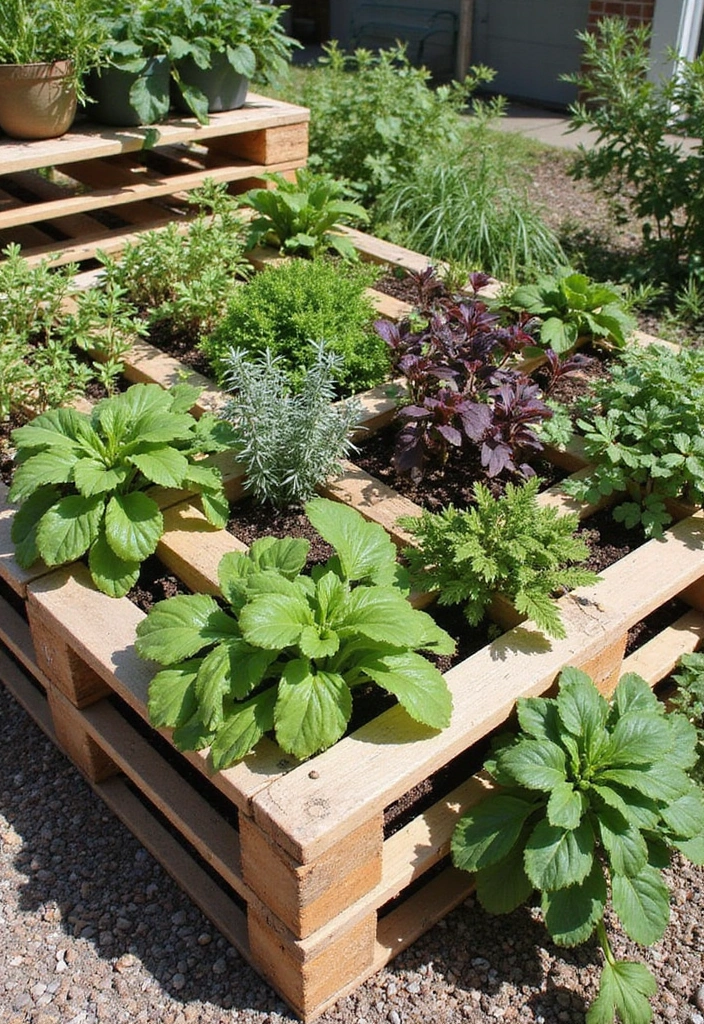
Give life to old pallets by transforming them into a tiered garden!
This budget-friendly option allows you to create multiple levels for planting while recycling materials at the same time. Simply secure the pallets vertically or at an angle, and fill the sections with soil and plants. You can grow anything from strawberries to leafy greens, making your pallet planter both decorative and functional.
Key advantages:
– Upcycled, eco-friendly choice
– Inexpensive way to garden
– Flexible placement options
Add a splash of color with annual flowers in the openings and ensure adequate drainage by drilling holes if necessary. Consider using a vibrant wood stain to seal your pallets and give them a polished look. Regular maintenance is essential; check for pests that might invade the wooden areas, and keep your plants well-watered.
Transforming old pallets into tiered gardens is not just eco-friendly; it’s a budget-friendly way to grow your own food in style. Elevate your gardening game and watch your garden flourish!
5. Cascading Vegetable Tiers
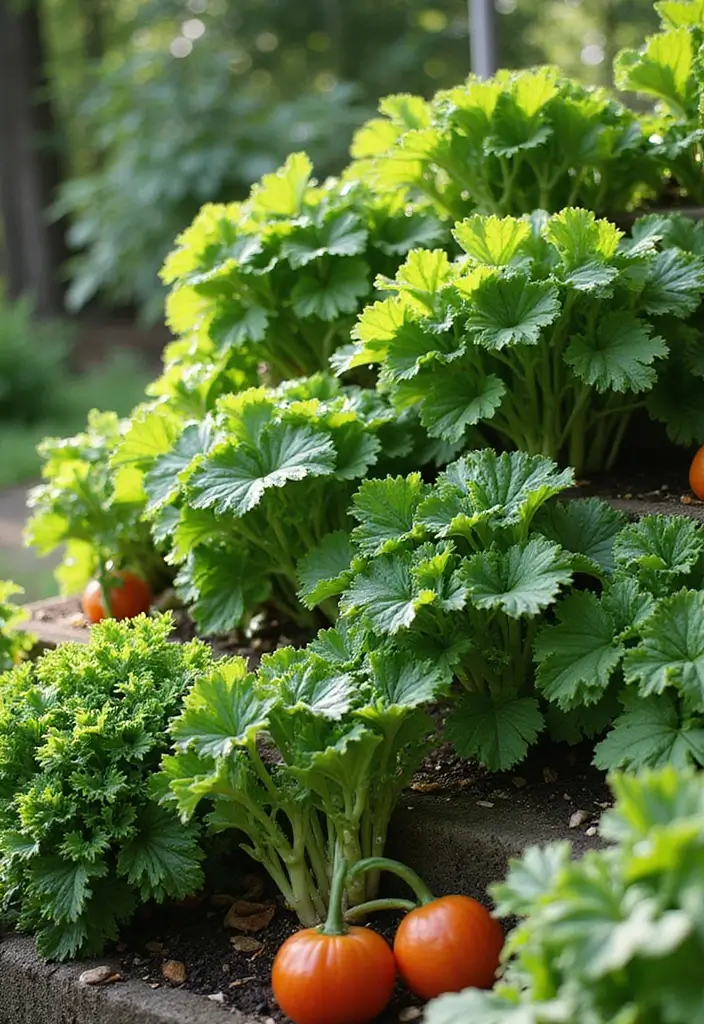
Imagine a garden where your vegetables are displayed in cascading tiers, creating a stunning visual feast.
This design can be crafted using wooden frames, concrete blocks, or tiered planters. Each level can house different vegetables, allowing for easy harvesting and a beautiful arrangement. The cascading effect creates an appealing flow and maximizes your space efficiently.
Benefits:
– Maximizes sunlight exposure
– Easy access for harvesting
– Unique design that stands out
Consider growing vining plants like cucumbers or peas that can cascade down, while lettuce and radishes fill in the lower tiers. This method also allows for companion planting; for instance, plant marigolds among your veggies to deter pests. Regularly check for moisture, especially in the top tiers, as they can dry out more quickly than the lower ones.
6. Wooden Stacked Planters
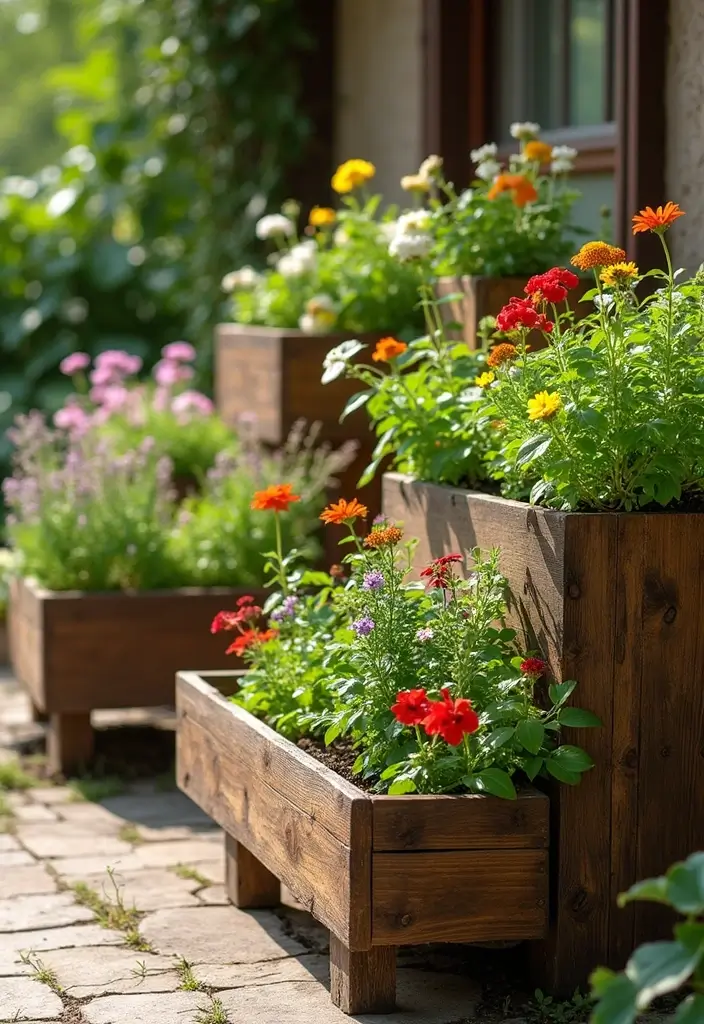
Wooden stacked planters are an elegant way to achieve a tiered gardening effect while adding rustic charm to your outdoor space.
You can create these by stacking wooden boxes or using planters built to fit together. This design is perfect for both flowers and vegetables, and it adds a sculptural element to your landscape. As the seasons change, you can update the plant selection to keep your garden looking fresh.
Why consider this option:
– Versatile for various plants
– Easy to move if needed
– Adds a unique architectural element
To enhance the look, paint or stain the wood in colors that complement your home or garden. Incorporate trailing plants that spill over the edges for added beauty. Be mindful of watering; the top tier may dry out faster, so keep an eye on soil moisture levels.
7. Vertical Fruit Garden
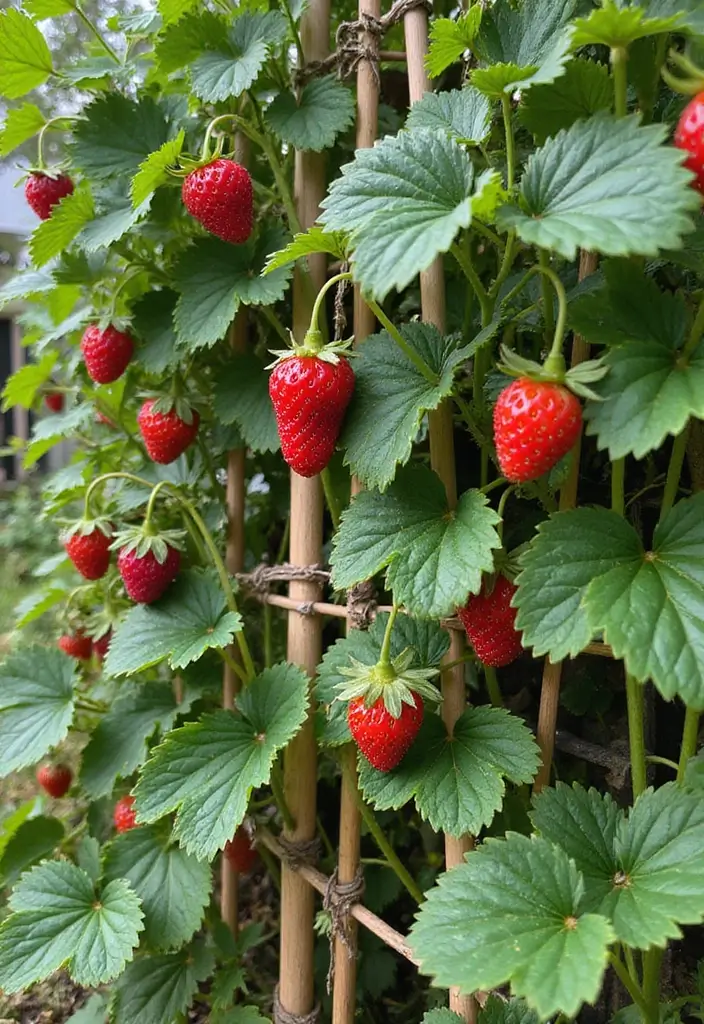
Why not grow your own fruit in a vertical garden?
This idea allows you to cultivate berries, grapes, or even dwarf fruit trees in an organized, space-saving manner. Using trellises, wall-mounted planters, or tiered pots, you can create a stunning visual while enjoying the freshest fruits right from your garden.
Top fruit choices:
– Strawberries in hanging baskets
– Raspberries trained up a trellis
– Dwarf apple trees in pots
This garden design not only maximizes your vertical space but also makes harvesting a breeze. Be sure to pick varieties that suit your climate and ensure they have enough sunlight. Regular pruning can help maintain the shape and encourage more fruit production, while trellising can keep the plants healthy and well-ventilated.
8. Vertical Flower Wall
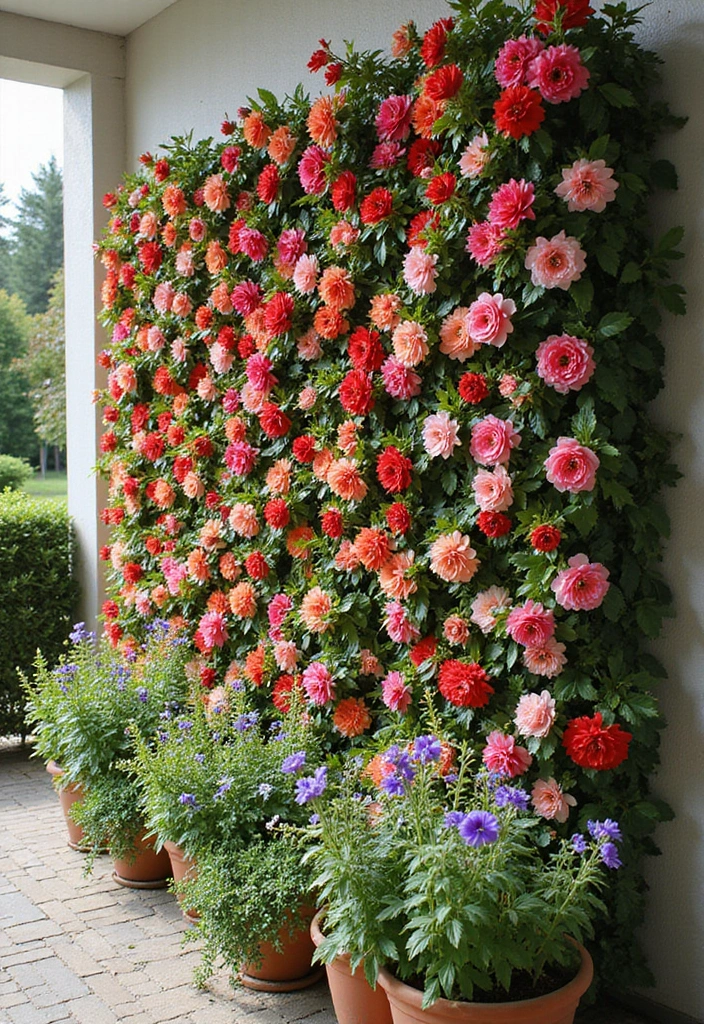
Brighten up any space with a vertical flower wall!
Using a framework of pallets or wall-mounted containers, you can create a stunning display of cascading flowers that not only beautifies your garden but also attracts pollinators. Choose vibrant annuals or perennials, and mix different heights and colors for an eye-catching effect.
Benefits of a flower wall:
– Dramatic visual impact
– Space-efficient gardening
– Enhances biodiversity in your garden
Ensure good drainage and sunlight for the flowers you select. Regular maintenance includes deadheading spent blooms and keeping the soil moist. Consider using a mix of trailing plants for added texture and interest; petunias and lobelia can be excellent choices for a colorful display.
9. Trough Gardens
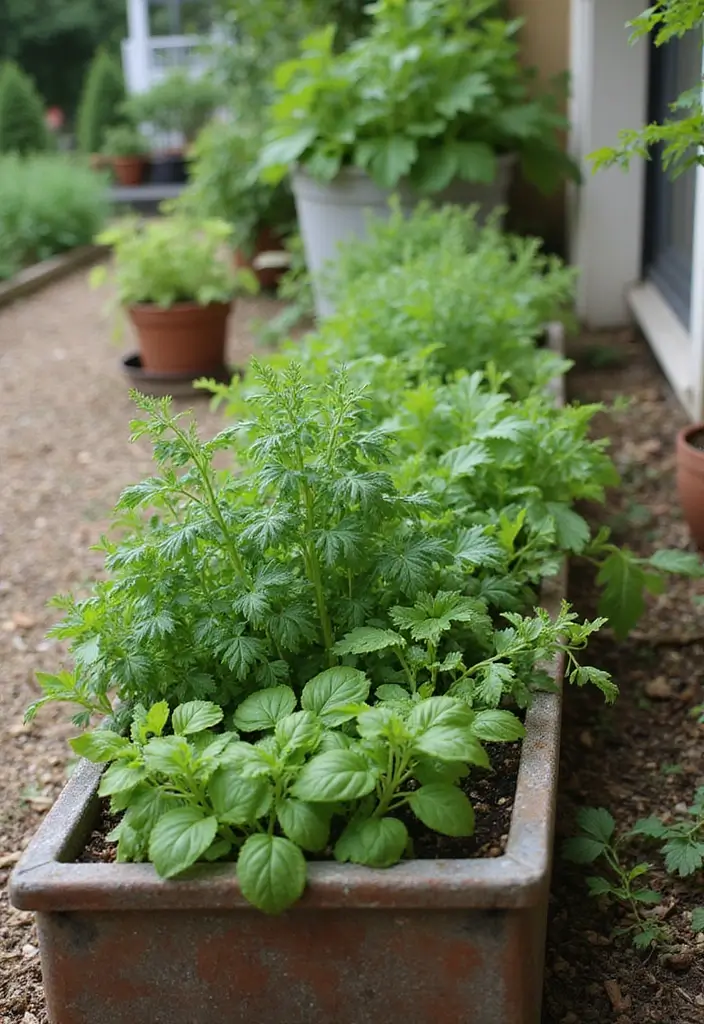
Trough gardens bring a charming touch to any outdoor space.
Using old metal or wooden troughs, you can create tiered levels filled with a variety of plants, from herbs to vegetables. The rustic appeal of troughs adds character while efficiently utilizing space. They can also provide good drainage for your plants, which is essential for a thriving garden.
Why trough gardens?
– Unique and stylish
– Portable and easy to rearrange
– Perfect for herbs or small veggies
Customize your troughs with distinctive arrangements to capture your personality. Group different galvanized troughs together for a stunning visual or alternate heights for a layered effect. Regularly check the moisture levels since they may require more frequent watering, particularly in the summer months.
10. Greenhouse Tiers
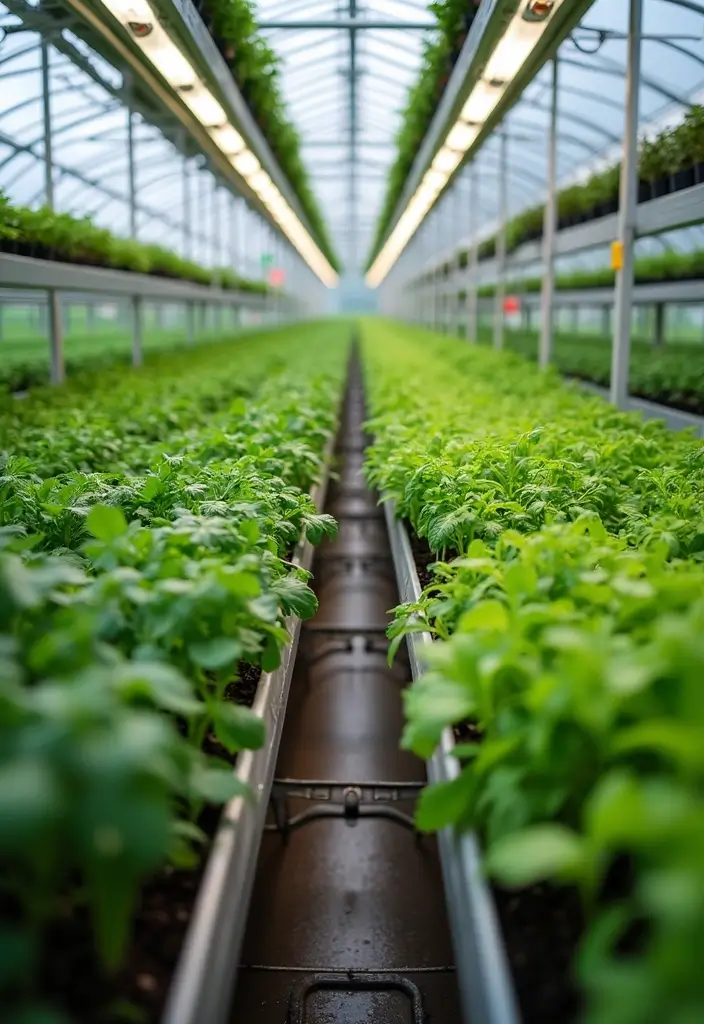
Maximize your gardening potential with greenhouse tiers, where climate control meets vertical gardening.
Inside a greenhouse, you can create multiple levels of plant growth, optimizing sunlight and space. Utilize shelving or hanging pots to house plants at various heights, ensuring an organized and efficient layout. This technique is excellent for starting seedlings or growing delicate herbs that thrive in a controlled environment.
Benefits:
– Controlled environment for optimal growth
– Efficient use of limited space
– Protects against pests and adverse weather
As you design your greenhouse, think about the height of each shelf and the plants you’ll grow. You might consider using wire racks for easy access to all your plants, and proper ventilation is key to healthy growth. Rotate your crops to keep the soil healthy and reduce the risk of disease.
11. Hanging Basket Garden
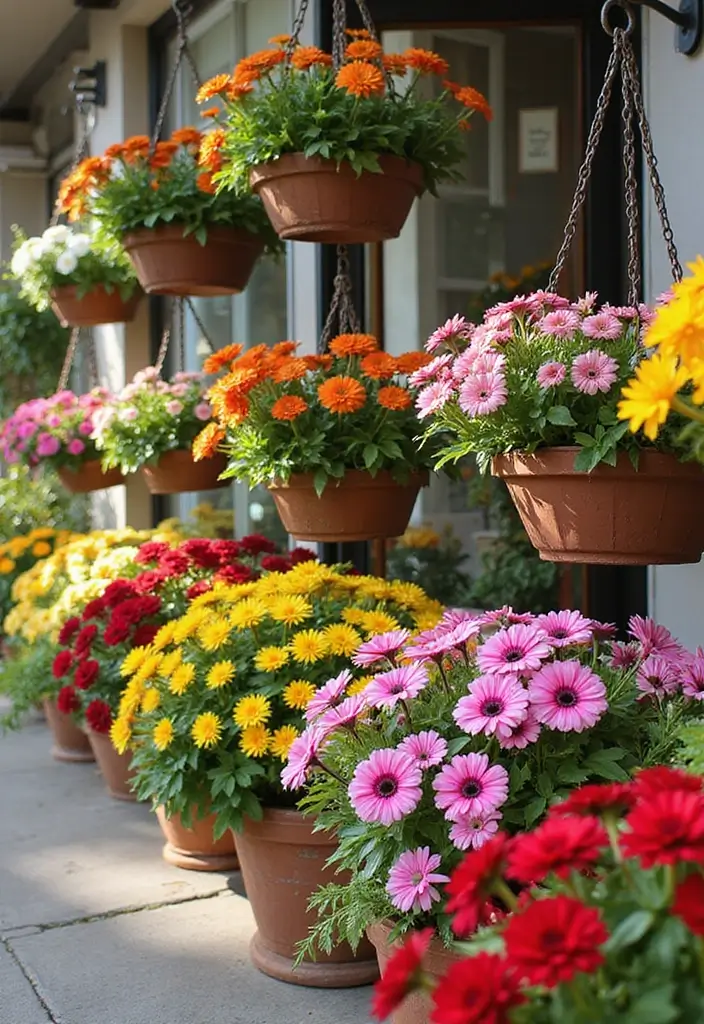
Elevate your gardening game with a hanging basket garden!
Using various sizes of baskets, you can create a stunning visual display while maximizing the use of vertical space. These baskets are perfect for trailing plants like petunias, or even small vegetables like cherry tomatoes that can spill gracefully over the edges.
Why go for hanging baskets?
– Adds depth and dimension to your garden
– Ideal for limited spaces
– Easy to manage at eye level
Mix and match colors and textures for an eye-catching arrangement. Be sure to keep an eye on moisture levels, especially in warmer weather, as hanging baskets can dry out quickly. Regularly fertilizing will ensure your plants stay healthy and vibrant throughout the growing season.
12. Tiered Container Gardens
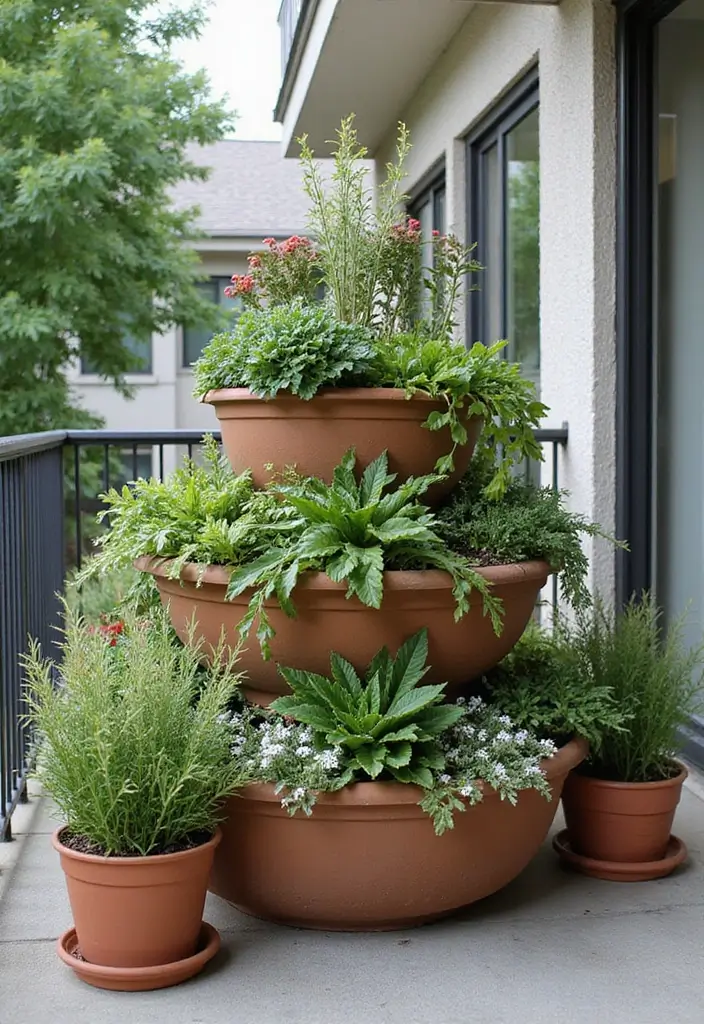
If you love gardening but have limited space, tiered container gardens might just be your perfect solution.
Using different sizes and styles of pots, you can stack them to create a beautiful layered effect. This method allows you to plant a variety of flowers, herbs, or vegetables, all while saving valuable ground space.
What’s so great about container gardening?
– Flexibility in plant selection
– Easy to rearrange
– Great for patios or balconies
You can get creative with your container choices, using everything from ceramic pots to wooden crates. Ensure each container has adequate drainage; this is crucial for healthy plant roots. Regularly check soil moisture and nutrients to keep your plants thriving, and don’t forget to play with color and texture to create an eye-catching display.
13. Modular Vertical Garden
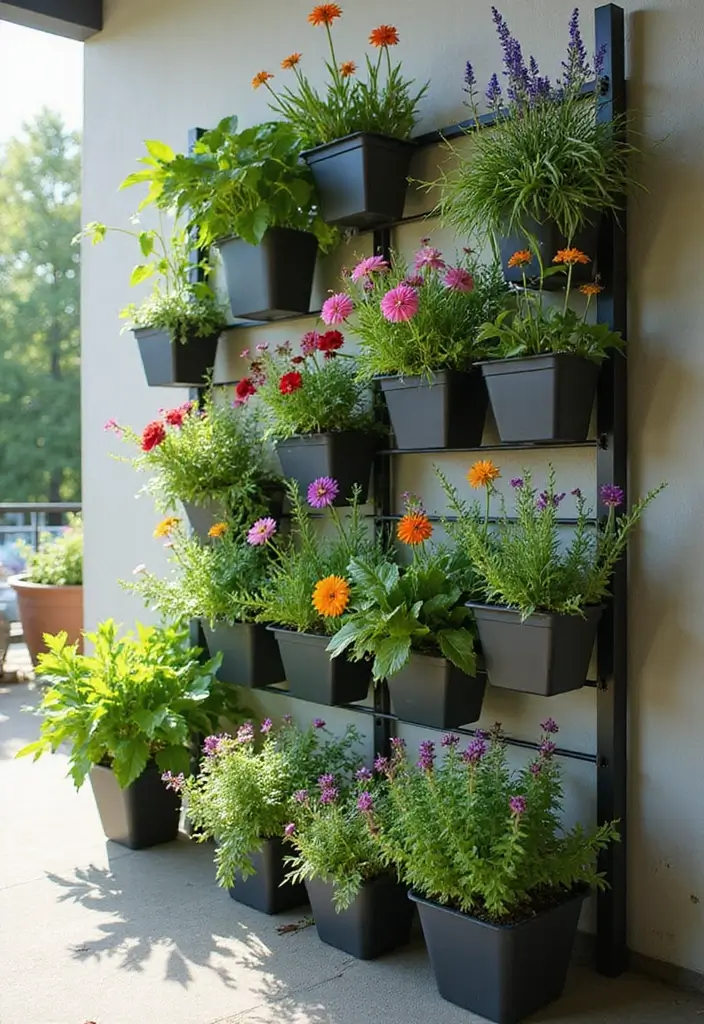
A modular vertical garden allows you to customize your gardening layout easily.
Using a framework of planters that can be rearranged, this setup gives you the flexibility to adapt and modify your garden as needed. It’s perfect for growing a variety of plants while maintaining an aesthetically pleasing appearance.
Benefits include:
– Customizable design
– Easy to maintain
– Space-saving solution
Consider planting a mix of herbs, flowers, and veggies to create a colorful tapestry. This also allows for easy access to all your plants, making harvesting stress-free. Regularly check for pests that might harm your plants, and rotate your crops for the best results. Adding trellises to your setup can provide additional support for climbing plants.
14. Garden Ladder Planter
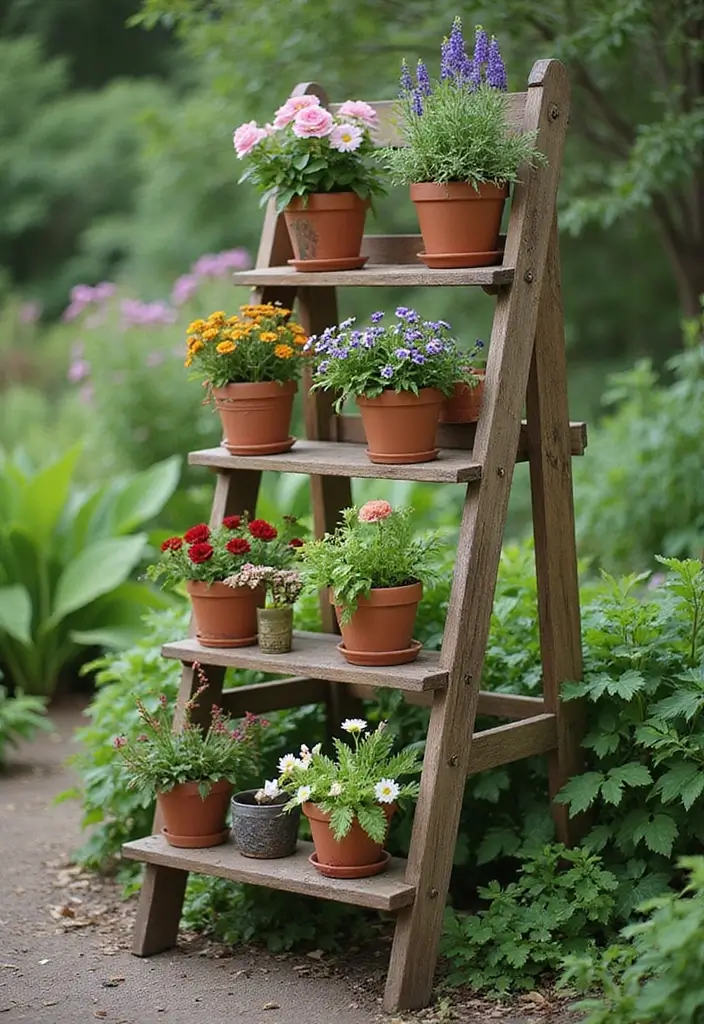
Turn an old ladder into a charming garden feature with a garden ladder planter!
This creative design utilizes the rungs of a ladder for planting pots at different levels, allowing for both practicality and visual interest. You can showcase a mix of flowers and herbs, creating an inviting look that catches the eye.
Why use a ladder planter?
– Unique and creative garden art
– Easy to customize
– Makes use of vertical space
Choose a sturdy ladder that can support the weight of the plants, and consider painting it to match your garden’s theme. Ensure each pot has good drainage and place it in a location that receives adequate sunlight. This playful garden element adds character and charm without requiring extensive space.
15. Hanging Vertical Garden with Planters
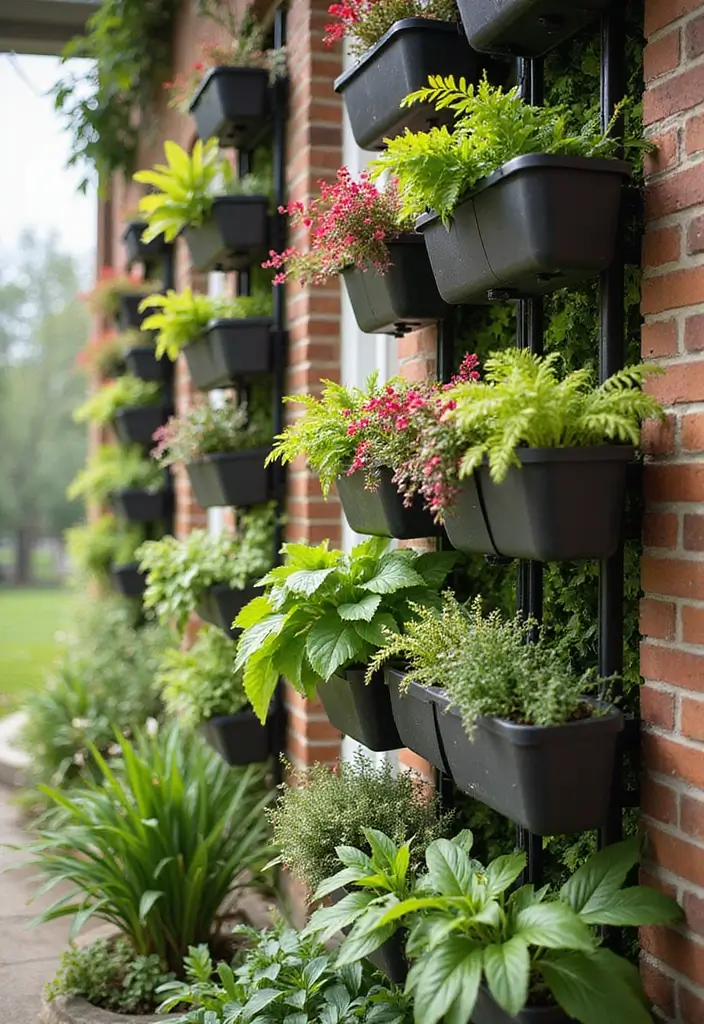
A hanging vertical garden with individual planters is another stylish way to utilize vertical space while showcasing your favorite plants.
You can use wall-mounted pockets or tiered planter boxes that hang down, creating a flowing look that’s both functional and beautiful. This style is perfect for small spaces or to create a dramatic focal point on your patio or balcony.
Benefits:
– Promotes airflow around plants
– Easy to maintain
– Adds height and drama to outdoor areas
Choose plants with different heights and colors to create a dynamic visual, incorporating trailing plants for a lovely cascading effect. Make sure your hanging planters are securely mounted, and provide adequate water access, especially in the heat of summer.
16. Tiered Rock Garden

A tiered rock garden combines natural stone with beautiful plant life, creating a stunning, low-maintenance landscape feature.
By stacking rocks in layers, you create micro-environments ideal for various plant types, especially succulents and drought-resistant species. This approach mimics nature and allows you to play with different textures and colors.
Why you’ll love it:
– Minimal water needs
– Unique, artistic appearance
– Supports diverse plant life
Incorporate decorative gravel or mulch between the rocks for a polished look. Consider adding a small water feature for tranquility and attracting wildlife. Regularly check the plants’ health and ensure that the rocks don’t block growth; moving them if needed can help create a more favorable growing environment.
17. Tiered Vegetable and Flower Combination
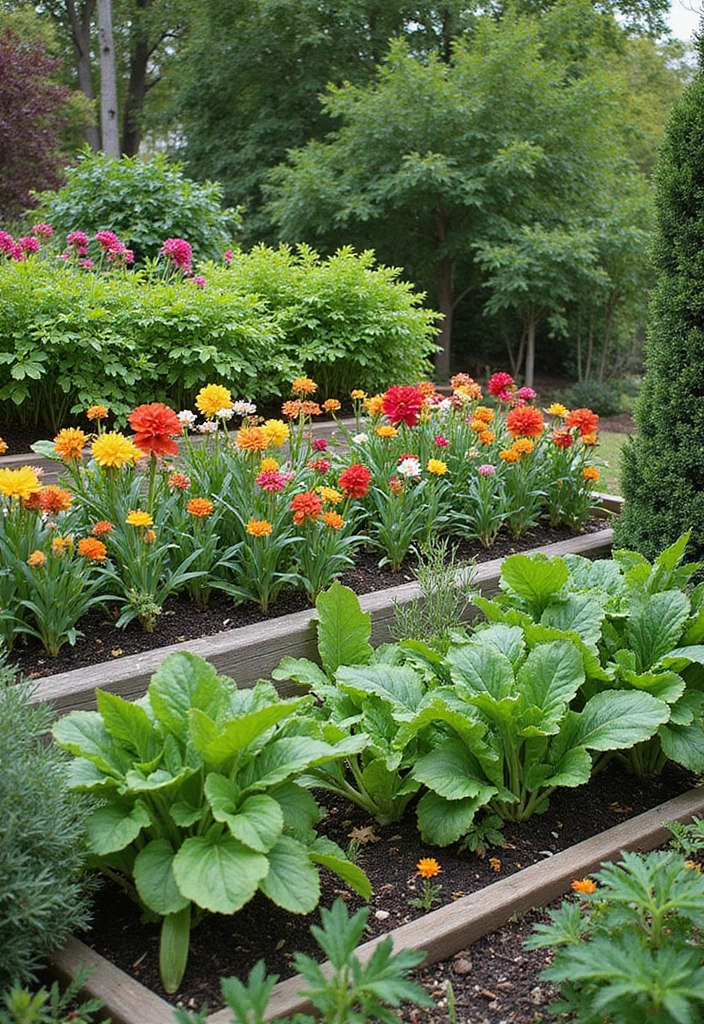
Why not mix vegetables and flowers in a tiered garden for a stunning display?
This approach allows you to have a picturesque design while also being productive in your gardening efforts. Plant vibrant flowers alongside your veggies, creating a colorful palette that attracts pollinators and enhances beauty.
Creative combinations:
– Marigolds with tomatoes
– Nasturtiums with greens
– Zinnias above carrots
This method not only creates a lush visual effect but also helps with pest control and encourages biodiversity. Be mindful of the sunlight needs of both types of plants, and ensure effective watering strategies to accommodate their requirements.
18. Vertical Succulent Garden
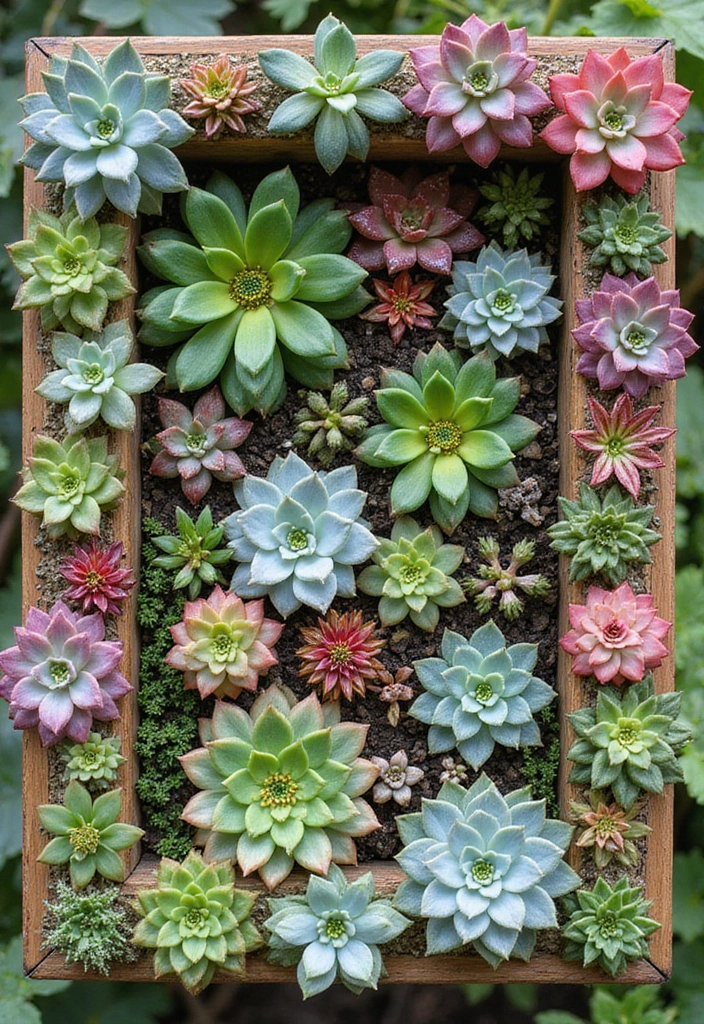
Bring a touch of the desert to your garden with a vertical succulent garden!
Using an array of small, low-maintenance succulents, you can create a stunning vertical display that thrives with minimal care. These hardy plants are perfect for sunny spots and can be arranged in a variety of creative structures, from wall-mounted frames to tiered planters.
Why choose succulents?
– Low water requirements
– Variety of colors and textures
– Easy to propagate
Arrange succulents in an eye-catching pattern, mixing different varieties for an eclectic look. Remember to use well-draining soil and pots to avoid root rot. These gardens are great for adding a modern aesthetic to your space while requiring little upkeep.
19. Multifunctional Tiered Garden

Why not combine functionality with beauty in a multifunctional tiered garden?
This type incorporates spaces for seating, walking paths, and planting areas, creating a holistic outdoor experience. You can build terraces or layers that integrate different functions, creating a serene retreat.
Benefits of multifunctional designs:
– Maximizes use of space
– Offers diverse gardening options
– Creates a relaxing atmosphere
Incorporate seating areas among the tiers with beautiful views of your plants and flowers. Pathways made of gravel or stepping stones can guide visitors through the garden. Make sure to choose plants that not only look good but also fit well within the functional areas you’ve designed.
20. Stacked Log Planter
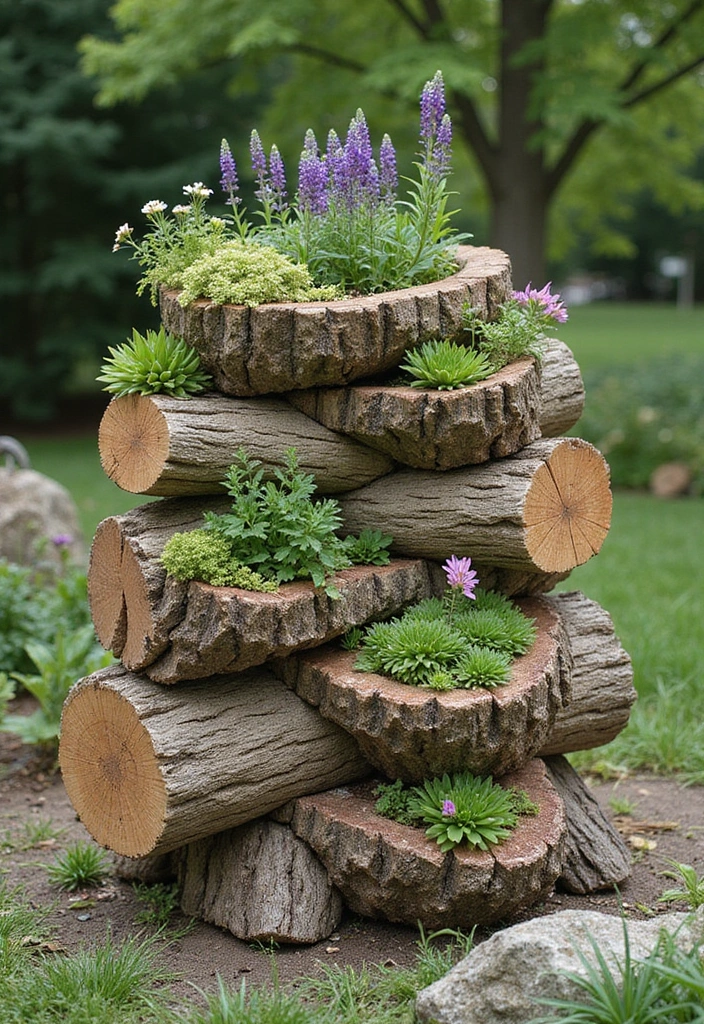
For a rustic, natural look, consider a stacked log planter!
Using sections of logs stacked vertically allows you to create a unique planting space that blends into the environment. This design not only looks great but also provides excellent drainage for your plants. You can plant flowers, herbs, or small vegetables in the logs, creating an appealing display.
Why go for logs?
– Eco-friendly and sustainable
– Adds charm to any garden
– Provides great aeration and drainage
Make sure to select untreated logs to prevent harmful chemicals from leaching into the soil. Group various logs together at different heights for added visual interest, and rotate your plants regularly to keep the soil healthy and thriving.
21. Vertical Bamboo Planter
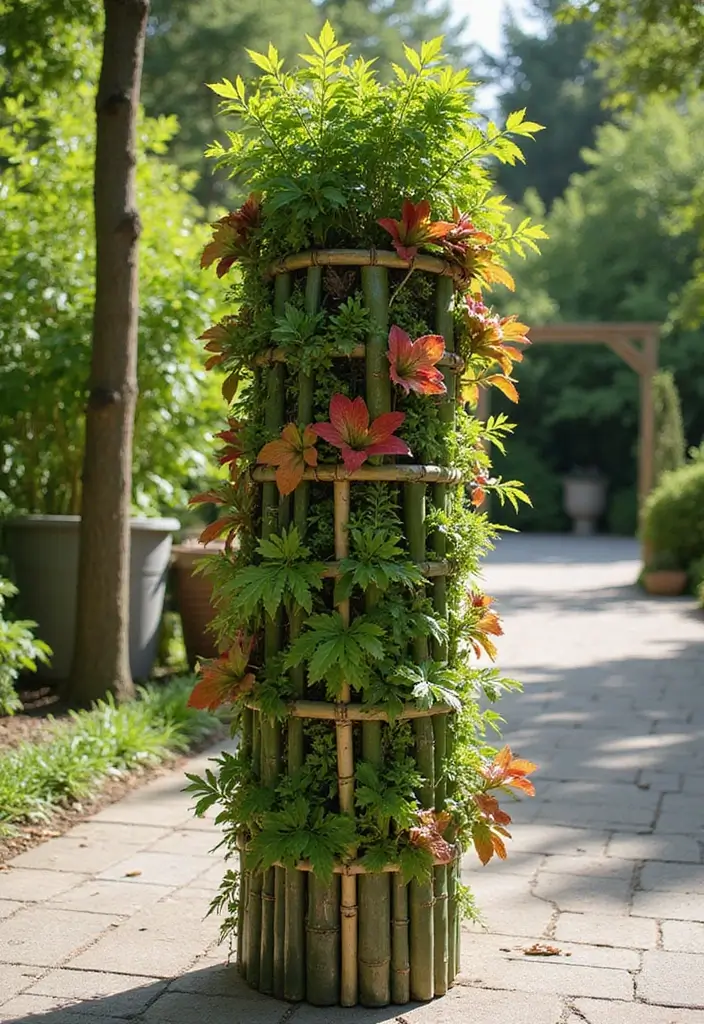
Utilize the unique properties of bamboo to create a vertical planter that stands out!
Bamboo is not only sustainable but also adds an exotic touch to your garden. By cutting bamboo stalks and arranging them upright, you can create a striking display for smaller plants, herbs, or flowers.
Why bamboo?
– Lightweight yet sturdy
– Eco-friendly and renewable
– Unique aesthetics
Choose plants that thrive in partial sunlight and ensure proper drainage within the bamboo tubes. You can even use bamboo stakes for trailing plants, allowing them to climb and create a lush display. Remember to regularly check for any pests or issues that may arise due to the structure.
22. Tiered Edible Landscaping
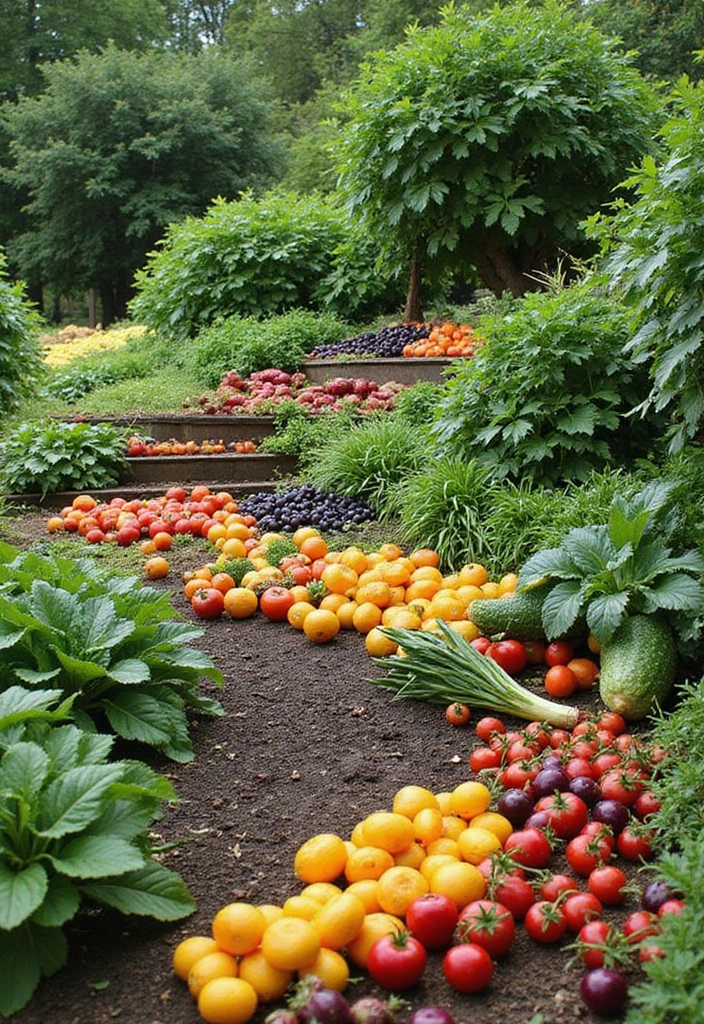
Incorporate edibles into your tiered garden design with edible landscaping!
This approach allows you to grow fruits, vegetables, and herbs in a visually appealing way while enhancing your outdoor aesthetics. Use tiered beds to create a stunning arrangement of colorful produce that can be both decorative and delicious.
Advantages:
– Combines beauty and functionality
– Promotes biodiversity
– Fresh produce at your doorstep
Arrange your edibles with care; using herbs like thyme and chives alongside stunning flowers can create a beautiful mix. Rotate your crops to maximize soil health, and consider interplanting to help reduce pests naturally. Regular maintenance will ensure a bountiful harvest and a beautiful space.
23. DIY Tiered Garden Stand
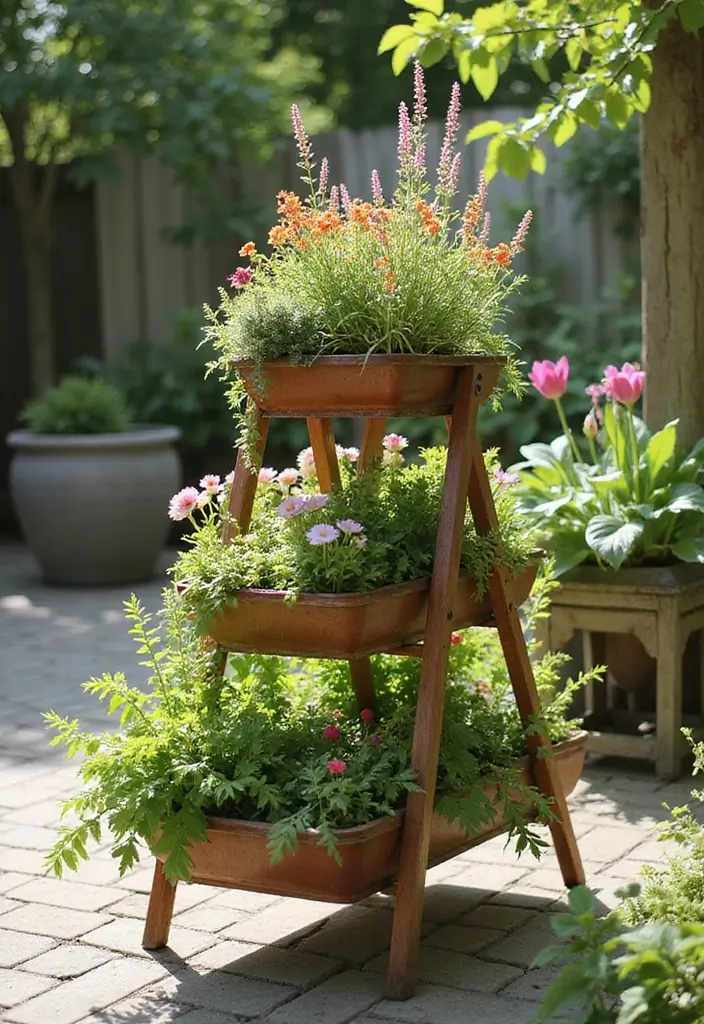
Create your own tiered garden stand for an organized and charming display of plants.
With a little creativity and some wood or metal, you can build a stand that showcases your favorite flowers, herbs, or vegetables in tiers. This setup not only saves ground space but also makes watering and harvesting extremely convenient.
Why a DIY stand?
– Customizable to your needs
– Offers easy access from all sides
– Looks great in any garden setting
Experiment with different heights for your tiers to create an eye-catching arrangement. Choose a durable material for longevity, and consider incorporating wheels for easy mobility. Regularly check for moisture needs and adjust your watering schedule based on plant requirements.
24. Fill with Colorful Annuals
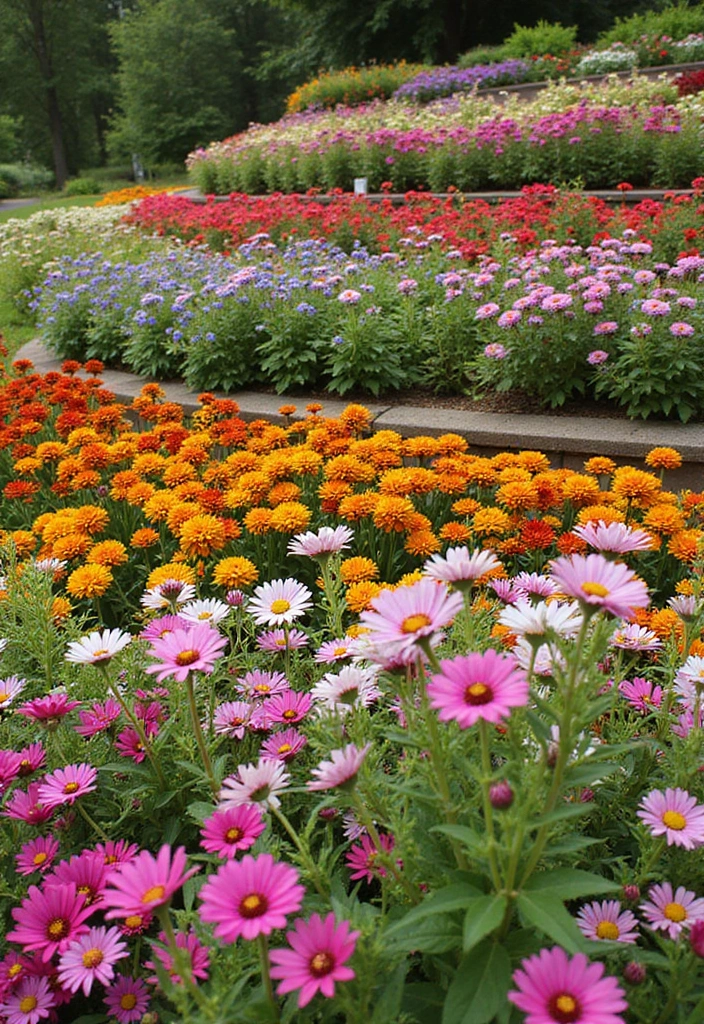
Focus on vibrant annuals in your tiered garden to create a stunning burst of color throughout the season.
These plants are known for their vivid hues and can be rearranged each year for a fresh look. Mix and match various types, such as petunias, geraniums, and marigolds, to keep your garden lively and inviting.
Benefits of annuals:
– Continuous blooming
– Wide variety of colors and shapes
– Easy to change each season
Plan your layout according to the light requirements of different plants and ensure they have enough space to grow and flourish. Regular deadheading and fertilization will encourage new blooms, keeping your garden looking vibrant all season long.
25. Create a Water-efficient Garden

Incorporate principles of water efficiency into your tiered garden design to promote sustainability and reduce maintenance.
Using drought-resistant plants and efficient irrigation methods can create a beautiful garden with minimal water use. Design your tiers to allow for natural water drainage, and use mulch to retain moisture.
Advantages of a water-efficient garden:
– Reduces water consumption
– Low-maintenance
– Supports local wildlife
Select native plants that are well adapted to your climate, allowing you to build a garden that thrives with little intervention. Regularly assess the moisture levels and adjust your watering practices based on weather conditions.
26. Vertical Palette Planters
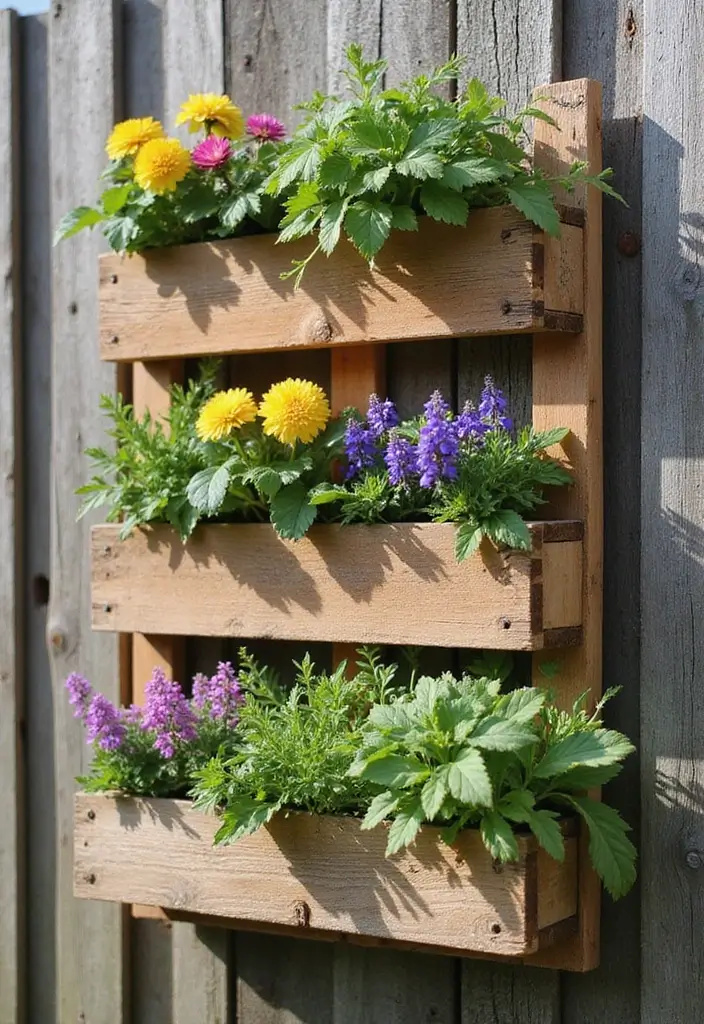
Embrace the trend of palette gardening with vertical palette planters!
These fun and functional planters bring a unique style to your garden while maximizing space. By securing pallets vertically against a wall or fence, you can create a vibrant living space filled with flowers or herbs.
Benefits include:
– Budget-friendly and eco-conscious
– Easy to rearrange for seasonal changes
– Great for small areas
Be sure to line the back of the pallet with landscape fabric to keep soil in place and allow for drainage. Regular watering and fertilization will keep your plants healthy and happy as they thrive. This trendy garden element is a creative way to add character while utilizing vertical space efficiently.
27. Use of Trellises in Tiered Gardens
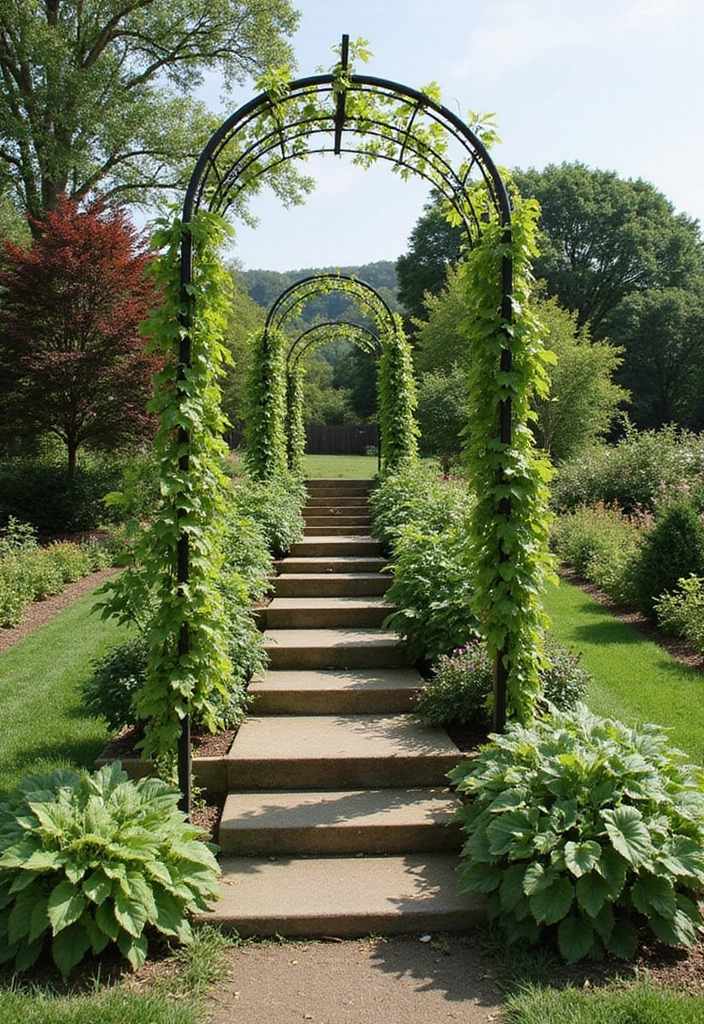
Adding trellises to your tiered garden can provide structure and support for climbing plants while enhancing its beauty.
These vertical supports can be integrated into your design, allowing you to grow vegetables like beans or peas that can spiral upwards while leaving more floor space for other plants. Trellises also add height and dimension to your garden.
Why trellises?
– Maximizes space
– Aesthetic appeal
– Supports healthy plant growth
Consider training your plants carefully, ensuring they’re well secured to the trellis without overcrowding. You can also add decorative elements to the trellis for added flair, such as twinkling lights or hanging decorations.
28. Incorporate Edible Flowers
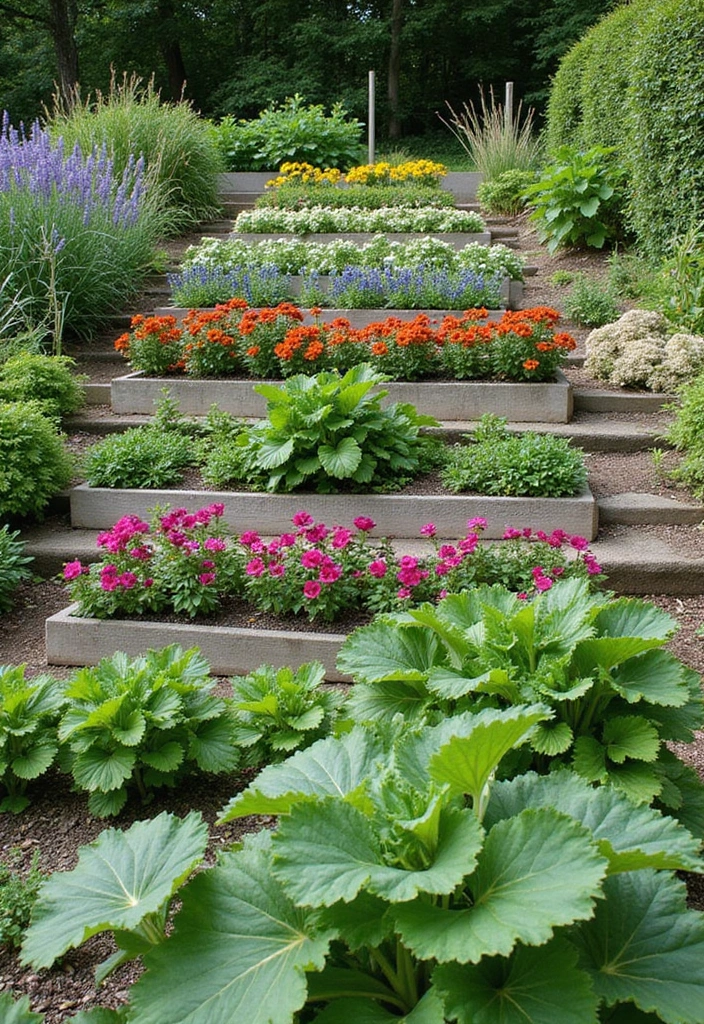
Elevate your tiered garden by incorporating edible flowers into your design!
These delightful blooms not only add beauty but also enhance your culinary creations. Consider planting nasturtiums, violets, or calendula, which can be used in salads or as garnishes. Their vibrant colors will brighten up your tiered garden while being functional.
Advantages:
– Adds flavor and beauty
– Attracts pollinators
– Offers culinary potential
Ensure that the flowers you choose are free from pesticides and safe for consumption. Incorporating these edible flowers among your vegetables can also help deter pests while creating a colorful and inviting garden.
Add a splash of color and flavor to your tiered garden! Edible flowers like nasturtiums and calendula not only beautify your space but enhance your meals, turning every dish into a culinary masterpiece.
29. Seasonal Rotation in Tiered Gardens
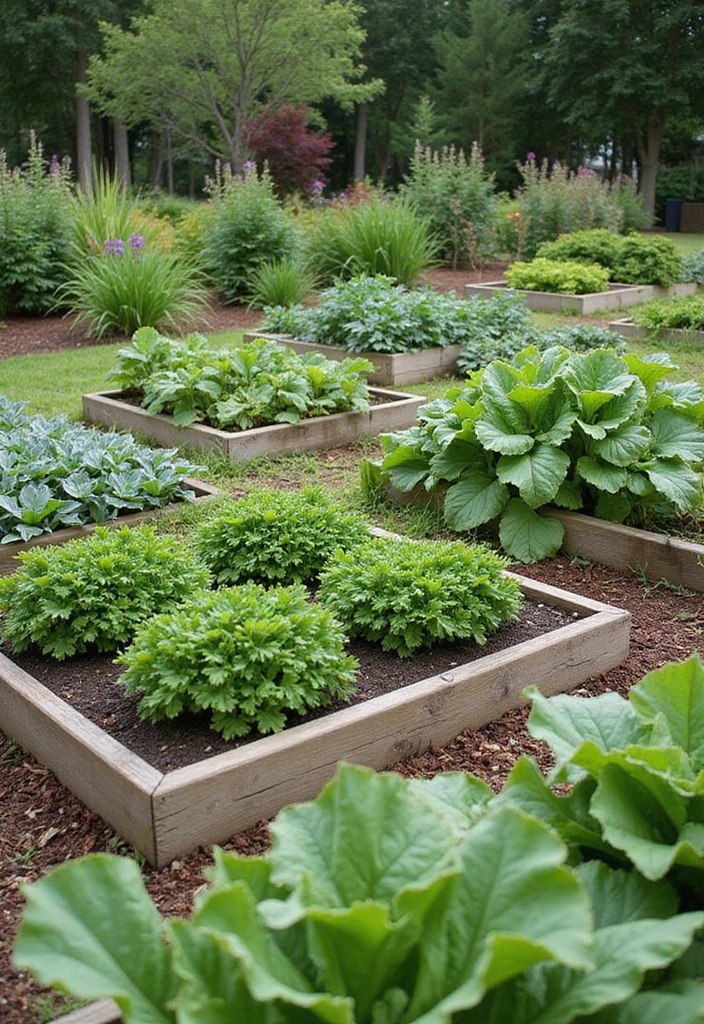
Implementing seasonal rotation in your tiered garden design is a smart way to keep your garden productive and healthy.
By planting different crops in the same space each season, you can optimize soil health and yield. This method also helps prevent pest infestations and diseases while maintaining the visual appeal of your garden.
Benefits:
– Enhances soil fertility
– Reduces pest buildup
– Keeps garden vibrant and productive
Plan your planting based on seasonal growth cycles, and keep track of what you plant where for future rotations. Continuous care and observation will ensure a thriving garden year-round.
30. Connecting Pathways Between Tiers

Create connection and flow in your tiered garden with beautiful pathways interspersed between the levels.
These pathways can be made from stepping stones, gravel, or even wood, guiding you through your garden while adding a touch of charm. Not only do they provide accessibility, but they also enhance the overall design by breaking up the visual space.
Benefits:
– Encourages exploration
– Improves accessibility
– Adds visual interest
Consider adding plants along the edges of the pathways for a lush and inviting feel. Regular maintenance of the pathways will ensure they remain clear and accessible, enhancing your garden experience.
A well-designed pathway invites exploration and adds charm to your tiered garden. Embrace the journey between levels, and let every step enhance your green oasis!
Conclusion
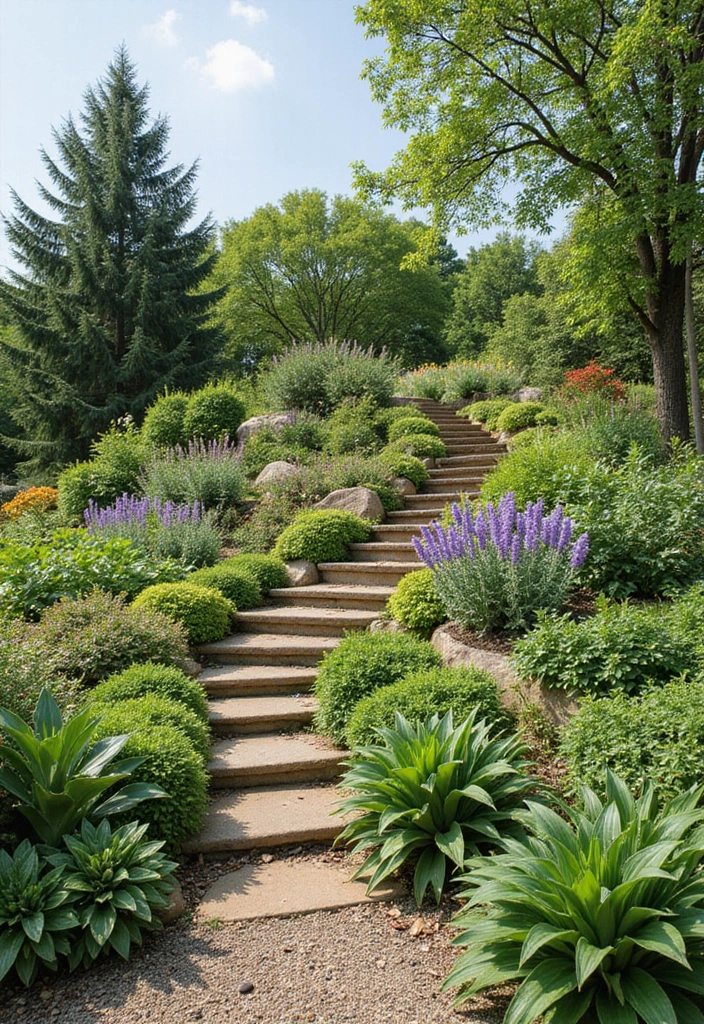
Tiered garden designs are a brilliant way to combine beauty and functionality in your outdoor space.
With so many creative options available, there’s something for everyone, whether you’re an experienced gardener or a newbie.
Start planning your tiered garden today, and enjoy the fresh veggies, beautiful blooms, and the satisfaction of nurturing your own green oasis!
Frequently Asked Questions
What are the main benefits of creating a tiered garden?
Creating a tiered garden offers numerous benefits! First, it maximizes your gardening space, allowing for more plants in a limited area. It also enhances drainage and reduces soil erosion, which is especially important for plants like vegetables and herbs. Plus, the multi-level design adds aesthetic appeal, creating a visually stunning garden that can serve as a focal point in your landscaping.
What types of plants work best in a vertical tiered garden?
When it comes to a vertical tiered garden, you have a range of planting options! Herbs like basil, parsley, and mint thrive in smaller spaces and are perfect for tiered structures. For a splash of color, consider annual flowers or succulents, which require minimal maintenance. If you’re looking to grow food, vegetables such as strawberries and lettuce are great choices that flourish in vertical setups!
How can I ensure my tiered garden is sustainable and water-efficient?
To create a sustainable and water-efficient tiered garden, focus on using drought-resistant plants that require less water. Incorporating a drip irrigation system can efficiently water your plants without waste. Additionally, consider adding mulch to retain moisture in the soil, and group plants with similar watering needs together to streamline your irrigation efforts.
Can I create a tiered garden on a sloped yard?
Absolutely! A sloped yard can actually enhance the beauty of a tiered garden. You can create retaining walls to define each tier and help with soil stabilization. This not only makes the most of your space but also offers unique landscaping opportunities. Just ensure you select appropriate plants that thrive in slightly different conditions as they might receive varying amounts of sunlight and moisture.
What are some budget-friendly materials to use for building a tiered garden?
Building a tiered garden can be done on a budget with a few creative materials. Pallets are an excellent choice, as they can be repurposed for various planter designs. You can also use bricks or cinder blocks to create sturdy tiers. For a more rustic look, consider using wooden logs or even recycled concrete to craft unique planting spaces. Just remember to treat any wood to prevent rot!
